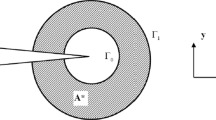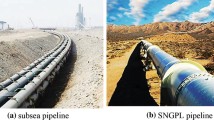Summary
The problem of the inner generative crack induced by the out-of-plane stress in front of the main through-the-thickness crack is discussed. The crack front of the inner generative crack is usually perpendicular to that of the main crack in the high strength pipeline steel. A three-dimensional (3D) semi-analytical method to estimate the stress intensity factor (SIF) of the inner generative crack has been proposed, based on the 3D two-parameter K–T z approach and Bueckner’s principle of superposition. Detailed comparison of the 3D semi-analytical, finite element (FE) and the corresponding plane strain solutions has been performed. It was shown that the 3D semi-analytical solutions agree well with the 3D FE results and they both are less conservative than the planar solutions. The influence of the inner generative crack on the SIF of the main crack was also analyzed.
Similar content being viewed by others
References
Irwin, G.R.: Fracture dynamics. Fracturing of metals, pp. 147–166. American Society for Metals, Cleveland (1948)
Irwin G.R. (1957). Analysis of stresses and strains near the end of a crack traversing a plate. J. Appl. Mech. Trans. ASME 24: 361–364
Rooke D.P. and Cartwright D.T. (1976). Compendium of stress intensity factors. Her Majesty’s Stationery Office, London
Newman J.C. and Raju I.S. (1981). An empirical stress intensity factor equation for the surface crack. Engng. Fract. Mech. 15: 185–192
Murakami Y. (1987). Stress intensity factors handbook. Pergamon Press, Oxford
Fett T. (1991). An analysis of the three-point bending bar by use of the weight function method. Engng. Fract. Mech. 40: 683–686
Tada, H., Paris, P.C., Irwin, G.R.: The stress analysis of crack handbook. The American Society of Mechanical Engineers (2000)
Guo W., Dong H., Lu M. and Zhao X. (2002). The coupled effects of thickness and delamination on cracking resistance of X70 pipeline steel. Int. J. Press. Vessels Pip. 79: 403–412
Dong H.R., Guo W. and Luo J.H. (2003). Mechanism analysis on delamination of pipeline steel and its effect on fracture. Mat. Mech. Engng. 27: 9–12
Yang Z., Huo C.Y. and Guo W. (2005). The charpy notch impact test of X70 pipeline steel with delamination cracks. Key Engng. Mater. 297–300: 2391–2396
Li H., Kurtz R.J. and Jones R.H. (1998). Effect of thickness and loading mode on the fracture properties of V-4Cr-4Ti at room temperature. J. Nucl. Mater. 258–263: 1386–1391
She C. and Guo W. (2007). The out-of-plane constraint of mixed-mode cracks in thin elastic plates. Int. J. Solids Struct. 44: 3021–3034
Nakamura T. and Parks D.M. (1988). Three-dimensional stress field near the crack front of a thin elastic plate. J. Appl. Mech. 55: 805–813
Bueckner H.F. (1958). The propagation of cracks and the energy of elastic deformation. J. Appl. Mech. Trans. ASME 80: 1225–1230
Guo W. (1993). Elastoplastic three-dimensional crack border field-I. Singular structure of the field. Engng. Fract. Mech. 46: 93–104
Guo W. (1993). Elastoplastic three-dimensional crack border field-II. Asymptotic solution for the field. Engng. Fract. Mech. 46: 105–113
Guo W. (1995). Elastoplastic three-dimensional crack border field-III. Fracture parameters. Engng. Fract. Mech. 51: 51–71
Henshell R.D. and Shaw K.G. (1975). Crack tip finite elements are unnecessary. Int. J. Numer. Meth. Engng. 9: 495–507
Barsoum R.S. (1976). On the use of isoparametric finite elements in linear fracture mechanics. Int. J. Numer. Meth. Engng. 10: 25–37
Williams M.L. (1957). On the stress distribution at the base of a stationary crack. J. Appl. Mech. 24: 109–114
Levy N., Marcal P.V. and Rice J.R. (1971). Progress in three-dimensional elastic–plastic stress analysis for fracture mechanics. Nucl. Engng. Des. 17: 64–75
Kassir, M.K., Sih, G.C.: Three dimensional crack problems. In: Sih, G. (ed.) Mechanics of fracture, vol. II. Noordhoff International Publishing, Leyden (1974)
ASTM E561–81: Standard test method for R-curve measurement (1981)
Author information
Authors and Affiliations
Corresponding author
Rights and permissions
About this article
Cite this article
She, C., Guo, W. Stress intensity factors for the inner generative crack induced by the out-of-plane stress in front of the main through-the-thickness crack. Acta Mech 200, 45–57 (2008). https://doi.org/10.1007/s00707-007-0577-y
Received:
Accepted:
Published:
Issue Date:
DOI: https://doi.org/10.1007/s00707-007-0577-y




